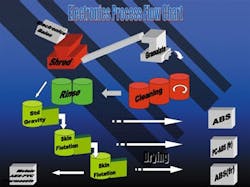Flotation reclaims plastics
At the beginning of the year, Recovery Plastics International (RPI), Salt Lake City, started up a line capable of handling 1,000 lb/hr of end-of-life computer plastics and another line to process a similar quantity of television housings. The two lines share a grinder; only one line can operate at a time, says Ron Kobler, president of the firm.
The computer waste consists of housings and other components primarily made of acrylonitrile butadiene styrene (ABS) and polycarbonate ABS (PC/ABS). The waste also contains metals, rubber, other polymers, ceramics, glass and even wood. The process provides about 90% recovery of the two plastics and produces three products: ABS, ABS containing flame retardant and flame-retardant PC/ABS.
The line for the television housings, which largely consist of high-impact polystyrene (HIPS) contaminated with metal and glass, offers about an 80% yield of flame-retardant HIPS, Kobler says.
In the computer-scrap process, baled waste first goes to a shredder and then a grinder. Next, the ground material is washed and rinsed. Standard gravity separation follows, producing an ABS product stream that also contains up to 10% polystyrene.
Making flotation work
Recovery of plastics from computer scrap takes advantage of the differences in hydrophobicity of flame retardants to separate materials by skin flotation.
RPI’s so-called skin flotation relies on the attachment of air bubbles to produce separation. It employs two flotation circuits in series, adding different plasticizers to each. The first recovers flame-retardant PC/ABS, and the second yields flame-retardant ABS. The PC/ABS contains less than 3% ABS, and the flame-retardant ABS includes 5-10% PC/ABS. Residue, which includes metals and other plastics, is placed in a landfill.
The products are turned into pellets and can be processed like virgin material. The plain ABS has 20-25% lower Izod impact strength, Kobler says. The recovered flame-retardant polymers suffer a 10-15% decline in physical properties, he says, but retain their original flame-retardant qualities. The physical property losses should not be a major factor, he says, because the materials likely will be used in a blend with virgin polymer.
For a plant with 20 million lb/year capacity, Kobler estimates that plain ABS pellets can be produced for 40-45 cents per lb, compared to a price of 60 cents per lb or more for virgin material. Flame-retardant ABS pellets could be made for 40-48 cents per lb versus 70 cents per lb and up for new material, while flame-retardant PC/ABS pellets run 60-65 cents per lb against $1 per lb for virgin supplies. A television scrap line would yield HIPS pellets at 45-55 cents per lb, he says, compared to more than 60 cents per lb for virgin material.
At the moment, RPI is ramping up operations to three shifts (24 hr per day, 5 days per week). The greater availability of computer plastics — 300,000 lb are on hand at the plant — means that line runs about four times as frequently as the television housing one.
The company plans to operate the lines for at least another six months as it develops applications for the products. The goal, says Kobler, is to have a plant with 20 million lb/year output operating on the East Coast in 2006.
By Mark Rosenzweig, editor in chief

